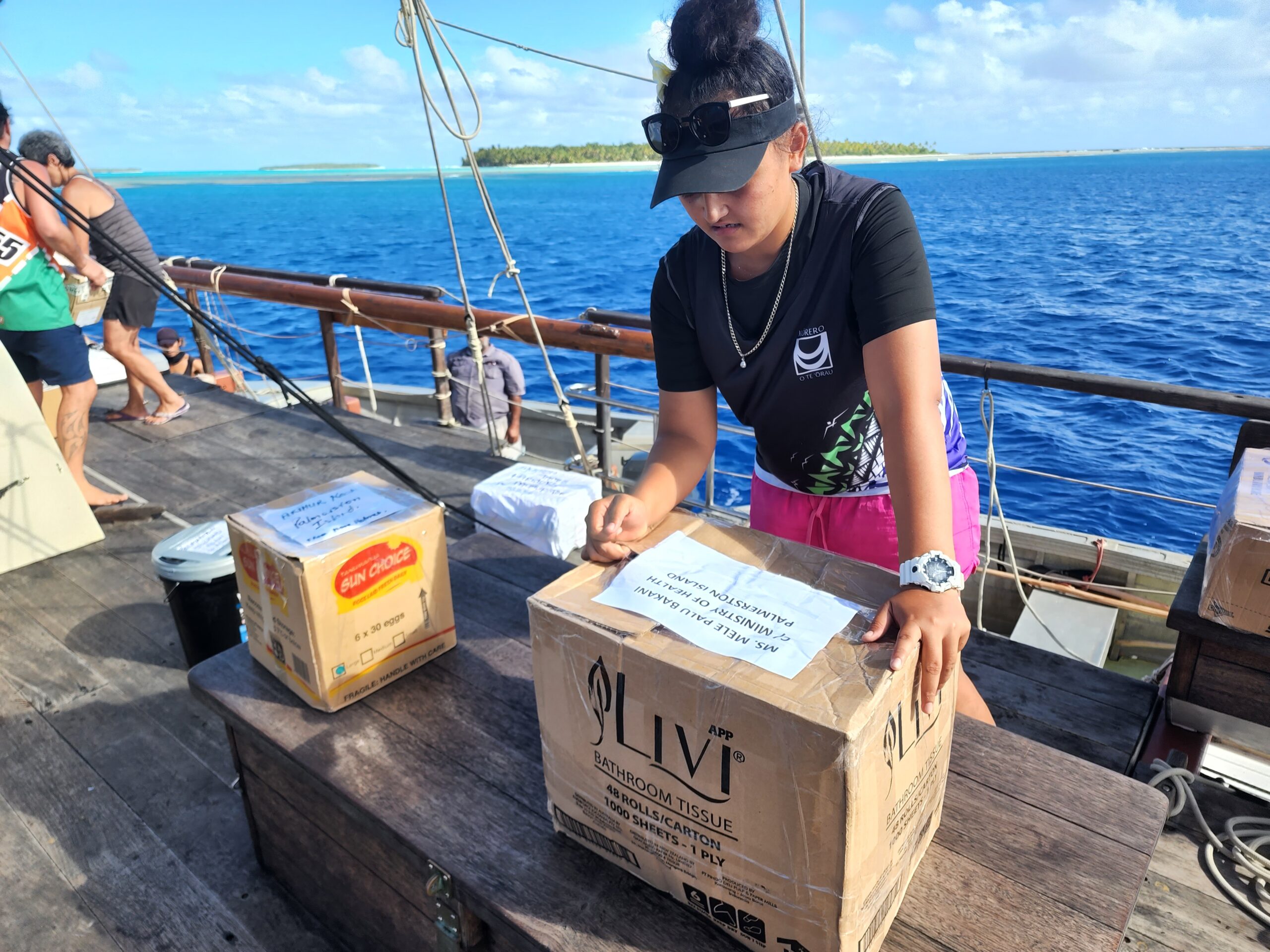Te Ipukarea Society: Palmerston Atoll bids farewell to rats
Sunday 24 September 2023 | Written by Te Ipukarea Society | Published in Environment, National

Julianna Marsters preforming the first official on board biosecurity check on Marumaru Atua, which picked up the Rat Eradication team. TIS/23092213
A rat eradication exercise has just been completed in Palmerston Atoll. This was for two main reasons.
First, rats cause damage to food crops and also can get into food stores, impacting the livelihood of local people.
Secondly, rats impact the biodiversity of the islands, including predating on seabird eggs and young seabirds, and eating young shoots of native vegetation.
It has taken roughly five weeks to complete this most recent rat eradication project in the Cook Islands, carried out on Palmerston Atoll.
The collaborative programme involved a team of eight field workers from outside of Palmerston, including reps from the New Zealand Department of Conservation, Cook Islands National Environment Service, Ministry of Agriculture, and Te Ipukarea Society.
This team worked alongside the Palmerston Island community to implement this project. The eight visitors proved almost a 30 per cent increase in the Palmerston population which was initially 28 people before the team's arrival.
Prior to the rat team arriving, Palmerston community had been busy preparing their island for the project.
This involved removing all chickens and livestock, or moving these animals temporarily to another rat free motu.
Based on a feasibility study conducted last year on Palmerston, it was found that chickens would eat the bait in large amounts, reducing bait availability for rats to feed on.
Active pig pens, where the pigs are fed daily, provide an alternative food source for rats, and were therefore also temporarily moved to a rat free motu.
Day to day lifestyle changes which were practiced and then implemented during the project included community members storing all food scraps in sealed buckets.
The food scraps were then either dropped at sea or fed to those pigs moved to the rat free motu.
New livestock will be sent to Palmerston, facilitated by the Ministry of Agriculture, once it has been declared safe to bring livestock back to home motu.
With the island prepared and alternative food sources scarce to come by for rats, the eradication team started the laborious task of track cutting through the bush to create island wide 20 x 20 metre grids on the two motu that harboured rat populations.
Each 20m point marks a baiting station where brodifacoum toxin was thrown in a circular pattern, with the goal of entirely covering both Cook’s and Home motu with bait.
Over 2000 baiting stations were created as a result.
There were also 109 structures, both vacant or occupied, that had their own special baiting stations.
Each room would have its own plate holding 10 individual baits which were checked every three to five days.
If a bait was missing this would be replaced, until eventually, the rate of disappearance started to decline.
The brodifacoum toxin contained in the baits works as an anticoagulant in mammals, preventing blood from clotting.
Fortunately, crabs or invertebrates are not affected by the toxin as they have different physical and chemical wound healing mechanisms.
As a precaution, a rau’i was placed on crab harvesting for several months to ensure there is no risk of humans consuming toxins which could have accumulated into crab muscle.
Baits were spread at three separate times, with around 10 days spacing in between.
Brodifacoum needs to be present for at least 20 days to ensure every rat eats one bait, and to also allow time for nesting rats to come out of holes to consume a bait.
During the first round of baiting rats were easily noticed both on Home and Cooks motu.
By the second round of baiting the team had not seen any live rats, though the “smell of victory” was more obvious by this stage. Not too bad however, as the wind would air out the stench.
A network of biosecurity devices was also built to allow for ongoing monitoring to prevent the chances of rats reestablishing.
Ongoing biosecurity will remain the responsibility of the community and biosecurity officer checking incoming cargo and items that are not fully sealed.
The rat team members have now returned back to their respective homes after being picked up by Marumaru Atua.
The Palmerston community now remains vigilant for the next month, as well as maintaining their daily practice of storing food scraps in sealed bins.
It will take about six months before we will know if the Palmerston rat eradication project was a success.
If successful, Palmerston will be the first rat free inhabited island in the Cook Islands and possibly South Pacific.
The only other one of the Cook Islands to date that has had rats eradicated is the uninhabited Suwarrow Atoll National Park.
The final rats were killed there by Te Ipukarea Society in 2022, after several previous attempts were only partially successful.
Rat eradication team members were: Emmanuel Oyston (DOC), James Ware (DOC), Jenny Long (DOC), Michael Mitchell (DOC), Julianna Marsters (Palmerston Community/ MoA), John Tuakana Marsters (Palmerston Community), Deon Frisbee (Palmerston Community), Teariki Tearetoa (NES), Ieremia Samuela (TIS), Henry Koteka (TIS), and Alanna Smith (TIS).
Palmerston Rat Eradication 2023 was funded by the New Zealand Ministry of Foreign Affairs and Trade through the MISCCAP programme.
- TIS




































